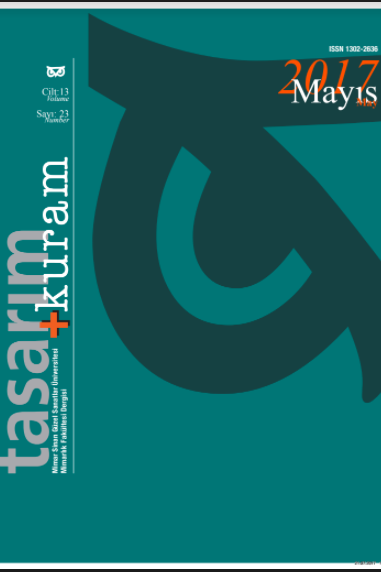Türkiye’de gerçekleştirilen çok katlı toplu konutlarda mekân standartlarının irdelenmesi (Ataşehir örneği)
Ülkemizde konut açığını kapatmak amacıyla, çeşitli toplu konutlar üretilmektedir. Bunların çoğu, taşıyıcı perde duvarlı sistemde tasarlanmakta ve bu strüktürel sistem, konut tasarımlarını doğrudan etkilemektedir. Günümüzdeki toplu konutlarda, çekirdek ailenin gereksinmeleri temel alınmaktadır. Kentsel yapılaşmaya gidilen örneklerde, çekirdek aile için, minimum yapı alanında, maksimum kullanım alanının sağlanmasına yönelik tasarımlar görülmektedir. Oysa, bir Türk Ailesi, ekonomik olanakları kısıtlı olsa bile, geleneksel ailenin etkisiyle, 80-90 m2.’lik konutları tercih edilmektedir. Dolayısıyla, günümüzde toplu konutlar, belirli standartların üzerinde yapılmaktadır. Bu çalışmada, ülkemizde gerçekleştirilen Ataşehir Toplu Konutları’ndan 10 kat ve üzerindeki bloklar örnek alınmıştır. Burada bulunan 2461 konut birimindeki mekânlar, bunların birbiriyle ilişkisi ve eylemler tespit edilmiştir. Eldeki bulgulara göre, mekânsal ilişkilerin oluşturduğu konut alan tipleri ortaya konmuş ve mekân büyükleri “Konut Mekân Standartları” ile karşılaştırılmıştır. Çalışmanın sonunda elde edilen bulgulardan, tasarımlarda çoğunlukla görülen alan tipi ve ıslak hacimlerdeki ilişki tespit edilerek, mekân büyüklükleri Konut Mekân Standartları ile karşılaştırılmıştır. Ayrıca her mekânda en çok yeralan eylem belirlenmiştir. Sonuçta; mekân büyüklüklerinin ihtiyaca ne denli cevap verdiği ortaya konmaktadır
Anahtar Kelimeler:
Ataşehir, Toplu Konut, Mekân Standartları, Eylem
The Analysis of the Standards of Residential Spaces in the High-Rise Buildings Constructed in Turkey: the Case of Ataşehir-İstanbul
In Turkey, mass housing is produced in order to find a solution for the lack of housing. This production is generally designed to construct the buildings with shear-wall systems and the construction management directly affects the design of the buildings. Today the core family is taken into consideration in the design of mass housing. However, no matter how limited is the income of Turkish Family, a minimum of 80-90m2 of houses are preferred by the effects of the tradional family. So, today’s mass housing is above the standards of residential spaces. In this research, the case of Ataşehir Mass Housing is taken into account. The spaces of the 2461 apartments, the actions and the relationships between spaces are considered. According to the results and findings, types of apartments formed by the different relationships are determined and the area of spaces are compared with the “Standards of Residential Spaces”. In the conclusion, determining the relationship between the mostly used spaces found in the house design, these are compared with the “Standards of Residential Spaces”. Also, actions taking place in the design of a residential space are determined. As a result, the question of “how the area of spaces meet the expectations in the mass housing” is answered.
Keywords:
Ataşehir, Mass Housing, Standards of Residential Spaces, Action,
- ISSN: 1302-2636
- Başlangıç: 1999
- Yayıncı: Mimar Sinan Güzel Sanatlar Üniversitesi
Sayıdaki Diğer Makaleler
500 Yıllık Değerli Bir Tasarım Mirasının Gerçekten Sahibi Olmak ve Bu Gücü Gerçekten Kullanabilmek
Merdiven, CARLO SCARPA ve İlk Basamak
Çağdaş binalarda güvenlik-kontrol sistemleri ve otomasyon
Depreme Dayanıklı Yapı Tasarımında Pasif ve Aktif Kontrol Sistemleri
tasarım+kuram'ın Doğuşu Üzerine
Batı Kentlerinin Gelişmesinde Bir Politika Aracı Olarak Tasarım
